You are reading the older HTML site
Positive Feedback ISSUE
11january/february 2004
Music, Sound and Personalities:
The 2004 CES and T.H.E. SHOW
by Dave Glackin
Photographs by Dave Glackin; image processing by David W. Robinson
This was my twentieth CES, and my twelfth as a member of the audio press. Am I jaded yet? Not a chance. And that’s mostly due to the people who populate this rabid madness called high-end audio. If it weren’t for people like Arnis Belgalvis, Brooks Berdan, Stig Bjorge, Cy Brenneman, Coleman Brice, Richard Broida, Vince Bruzzese, George Cardas, D. J. Casser, Ole Christensen, Dave Clark, Byron Collett, Ted Conger, Ric Cummins, Tim deParavicini, Les Edelberg, Bruce Edgar, Mike Garges, Duane Goldman, Frank Hale, Kevin Hayes, Roger Hassing, Keith Herron, Bob Hovland, Hart Huschens, Clark Johnsen, Alan Kafton, Chad Kassem, George Kielcyznski, Stan Klyne, Joe Knight, Barry Kohan, Robert Lee, Winston Ma, Mike Maduras, EveAnna Manley, Luke Manley, Peter McGrath, Philip O’Hanlon, Bobby Palkovic, Robert Pincus, Shane Rich, Stan Ricker, Lila Ritsema, David Robinson, Steve Rochlin, Kal Rubinson, Martina Schoener, Toy Shigekawa, Gus Skinas, Saul Sokolsky, Paul Stubblebine, Bruce Thigpen, Victor Tiscareno, Jeff Tonkin, Albert Von Schweikert, John Ulrick, Ron Welborne, and many more, this show would just be a soulless pile of hardware. But it’s not. Far from it. Thanks, folks, for making this such a blast year after year.
This was the seventh CES that I attended with Stan Ricker, musical and mastering maven extraordinaire, and an incredible friend to boot. Stan is like a heat seeking missile for good sound, and his company, good humor, and occasionally off-color remarks added immeasurably to the enjoyment of the show for me. Here’s to many more to come.
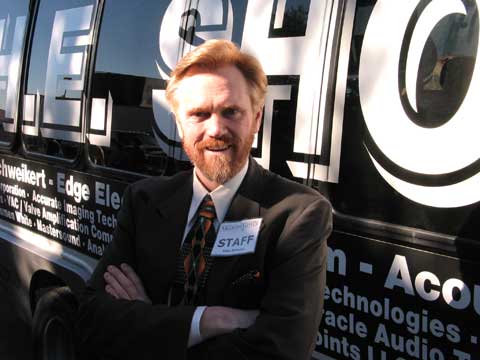
Mike Maloney of T.H.E. Show with one of his "magic buses"
Mike Maloney is to be congratulated for his production of T.H.E. SHOW this year. The quality of this maverick show has been like night and day compared to yesteryear when it was in other, far less capable hands. Mike moved the bulk of T.H.E. SHOW back to the St. Tropez this year, right beside the CES high-end show at the Alexis Park, making it much easier to cover. I’d like to give a special thanks to Mike for continuing to keep T.H.E. SHOW open for press day on Monday, since this is the only thing that allows me to cover the high-end audio in all three hotels with any depth. Providing meaningful coverage in just four days is something I find to be impossible. I made a special point of thanking all of the exhibitors who stayed for Monday, and would like to encourage the rest of the exhibitors at T.H.E. SHOW to do likewise next year. It will help to ensure them of better press coverage, especially from those of us who try to cover the whole show single-handedly.
I’d also like to say that the large rooms at the San Remo were a boon to T.H.E. SHOW. Last year I called one of the San Remo’s rooms the "Best Symphony Hall Experience" I’ve heard in my 25 years of listening to high-end audio, and that experience was convincingly repeated this year. I’m not sure that would have been possible in any of the rooms at the St. Tropez. You hit a home run this year, Mike.
Fun and Exciting Highlights
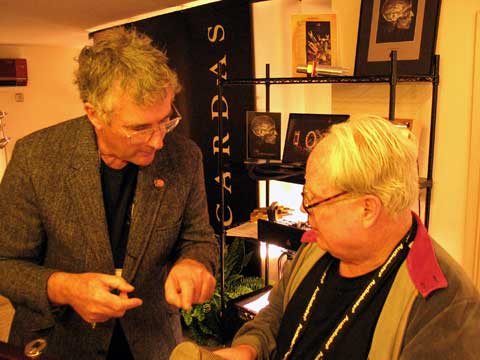
George Cardas expounds upon his new microphone design
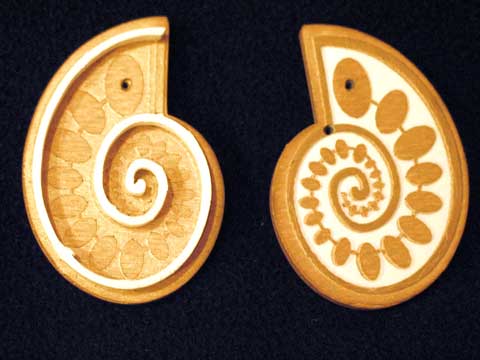
George’s prototype
George Cardas of Cardas Audio takes the award hands-down for the Most Creative New Technology. This excited me more than any other technical development in the show, and George kindly gave me an exclusive. The concept behind the "Golden Ellipsoid Microphone" is to make a microphone capsule that mimics the ear. The active cavity looks like the inside of a chambered nautilus, and it uses the golden ratio geometric progression that has served Cardas so well in other applications. The operating principle is that sound is progressively absorbed along the active area, and most significantly, it is absorbed by surfaces that are at equal tension. Most (but not all) microphones act like the head of a drum under compression. They tighten up under increased pressure, and they can make singers sound like their throats are tightening up. George has built an E49 dual-capsule prototype version of his microphone that he was proudly displaying. This is probably the first really new concept in microphones in some time. The company that is my choice for interconnect, loudspeaker, and power cables in my reference system continues to come up with innovative ideas. Godspeed, George.
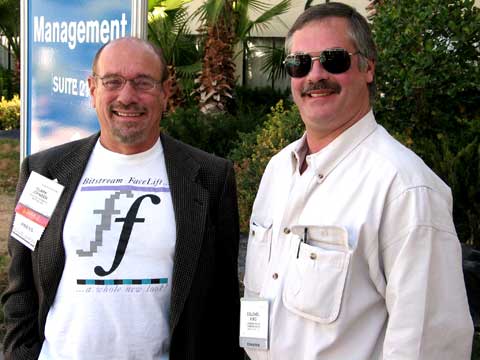
Clark Johnsen and D. J. "Col. King" Casser
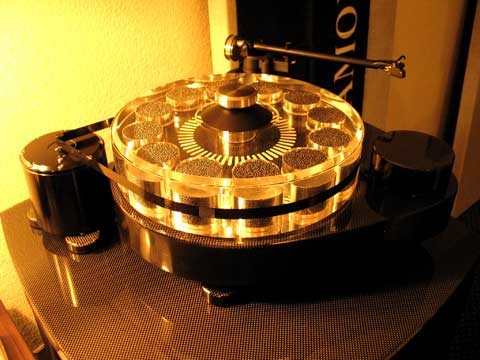
D. J. Casser of Black Diamond Racing exhibited the Most Exciting Turntable Modification. D. J. has always been inventive when it comes to the application of his carbon-fiber-and-epoxy-resin vibration control devices. Black Diamond Racing shelves, cones and pucks are firmly ensconced throughout my reference system. D.J. was exhibiting a modified Teres turntable, using a beautifully constructed Black Diamond Racing plinth. It was impossible, of course, to evaluate the effects of that modification under show conditions, but judging from what one of his shelves did under my turntable, the effects may be very significant. D. J. is also considering making replacement plinths for VPI TNT turntables. If that happens, I expect it to generate a lot of excitement (as well as controversy). D. J. was exhibiting with Mike Maduras of the Glass Amplifier Company. It was great to see you both this year, gentlemen!
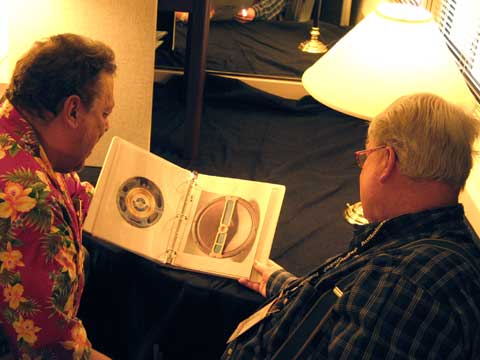
Mike Maduras and Stan Ricker slobber over a famous loudspeaker driver
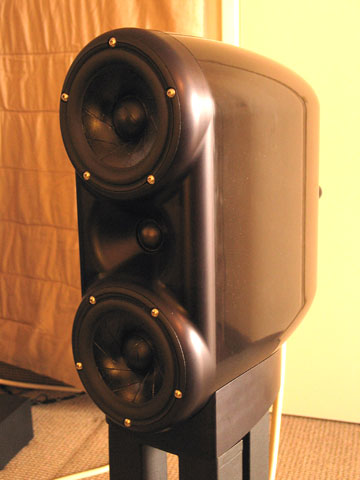
The Best New Small Loudspeaker was being shown by Dr. Karl Schuemann of AudioMachina. Dubbed "The Ultimate Monitor," this stand-mounted speaker sports a carbon fiber enclosure and three drivers in a d’Appolito configuration. Each comes with a heavy-duty ATA case for ease of transport. The sound from these babies was extraordinary. I am recommending these to my esteemed editors for a full review. [Arrangements for Dave’s suggested review have been made for later in the year here in River City.]
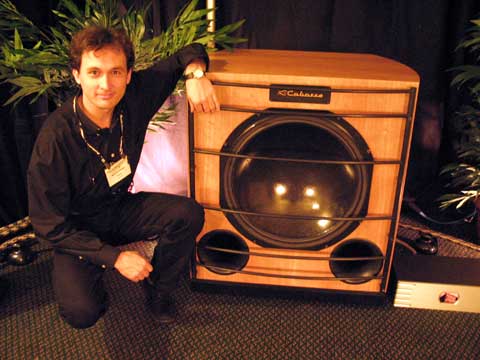
The Best Subwoofer at the show was in the Cabasse room. Designed by Dr. Bernard Debail, it uses a modified version of the 21-inch driver that is used in all OmniMax theaters in Europe, and it includes an integral 1000-watt amplifier. The cone employs a honeycomb structure that only weighs 100 grams total. Its reproduction of male voice chest tones was demonstrated to great effect using a Fairfield Four recording.
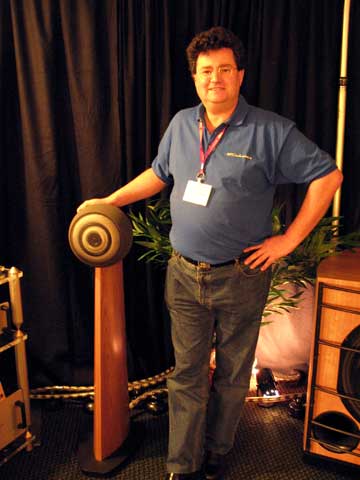
Christopher Cabasse
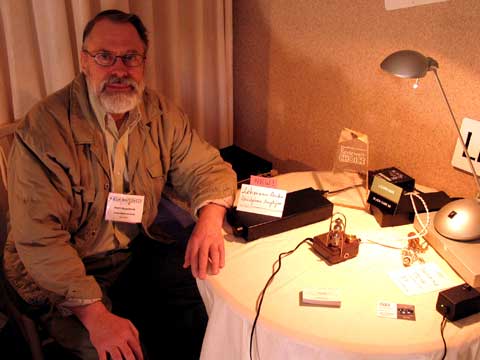
Hart Huschens of Audio Advancements
My Favorite Headphone Amplifier, now in its tenth year, was being displayed by Hart Huschens of Audio Advancements. The EarMax, a tiny tri-triode tyke, is an OTL amp that drives my Sennheiser 580 headphones beautifully. Hart was also exhibiting a great new small floor-standing loudspeaker, the Om model from the manufacturer fJ (für Johanna), whose modest appearance belies its excellent sound quality. Another new (to me) line for Hart is TRON electronics. The units I saw had very high build quality, and deserve further examination. Visiting with Hart is always a highlight of the show, and this year was certainly no exception.
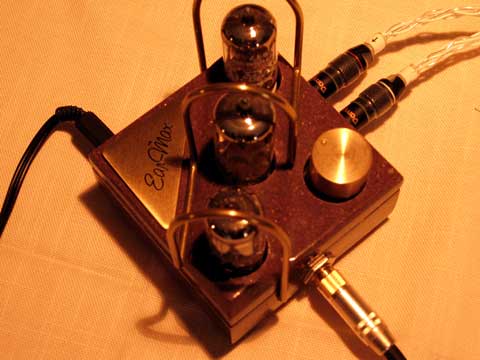
The EarMax headphone amplifier
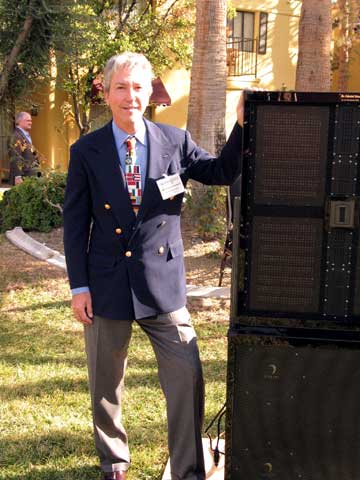
Albert and his PA system
The Best Public Address System at the show (yes, you read that right) was from Von Schweikert Audio. The loudspeakers used planar magnetic drivers for midrange and treble, and four cone woofers for the bass. We were treated to excellent sound through this system every day at lunchtime at T.H.E. SHOW, while we listened to the Misty River Band playing live. Speaking of which ...
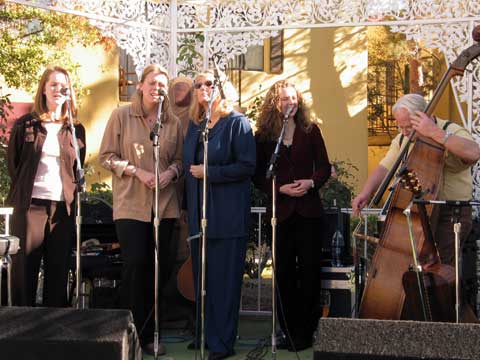
Misty River and Stan Ricker playing during the free lunch at T.H.E. SHOW
The Best Sound in the Show was "The A Capella Song," as performed by the Misty River Band in an all-acoustic set at TG Audio/CTC Builders in a small jam-packed room at the Alexis Park. Doing a combination of bluegrass, folk, and other art forms that they dubbed "Americana," this four-woman group hailing from the Portland, Oregon, area sang and played their hearts out. Their harmonies blended beautifully. Bob Crump of TG Audio/CTC Builders was the driving force behind Misty River's appearance in Las Vegas, following his introduction to their music by Jan Mancuso. He convinced the band that they should appear, and he convinced Mike Maloney likewise. Bob had been bowled over by Misty River's recorded and live performances, championed their cause with Maloney, and funded their appearance at the Alexis Park. Bravo. (This session goes undocumented, as my photos were egregious.)
Stan Ricker was fortunate enough to sit in on bass with Misty River several times. In an e-mail to the members of Misty River after the show, Stan said, "I'm still trying to peel myself off the ceiling for having the privilege of doing the obligato bass part behind your "America"! A hell of a thrill, pure music-making thru and thru!!! Thank you all for putting up with my unabashed unbridled enthusiasm—you didn't really think I came to all those lunches just to munch on 5 hot dogs a day, did you?!?!!????"
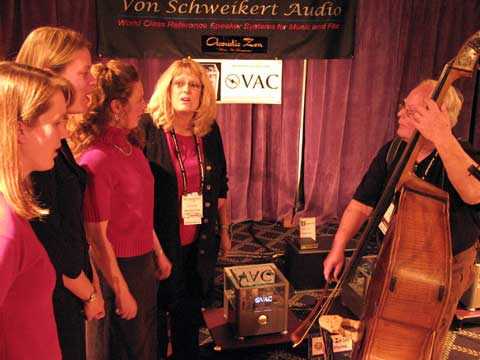
Misty River & Stan Ricker do "America", chills up the spine follow
The Most Fun at the Show was watching and hearing a recording workshop put on in the Von Schweikert Audio room at the San Remo. The audience got to hear the Misty River Band sing live, got to watch recording engineer extraordinaire Chris Huston work with the group and make adjustments in real time, and got to hear the playback over a big system consisting of amplifiers from Kevin Hayes of VAC, cables from Robert Lee of Acoustical Zen, room treatment from RPG, and loudspeakers from Albert Von Schweikert (the behemoth VR-11s). Room correction was done by Chris Huston and Richard Rives Bird of Rives Audio, using their analog-domain PARC (Parametric Adaptive Room Compensation) device. Recording was done with a Meitner DSD recorder. I was also quite taken by Rives Audio's catchphrase, "So you finally have the sound system to die for. Only your listening room is what's killing you." This session was an absolute blast and quite educational, and I thank everyone involved. My hat is off to Albert Von Schweikert for having the good taste to fund the appearance of Misty River at these workshops, as well as every single day (including Monday) at lunchtime at T.H.E. Show.
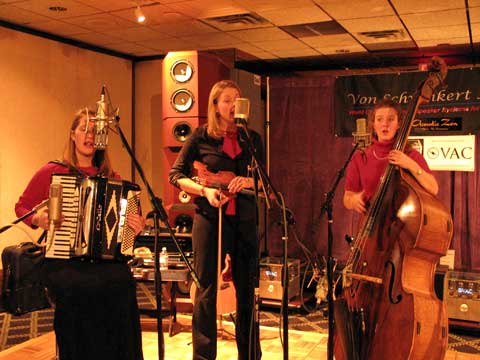
Recording workshop
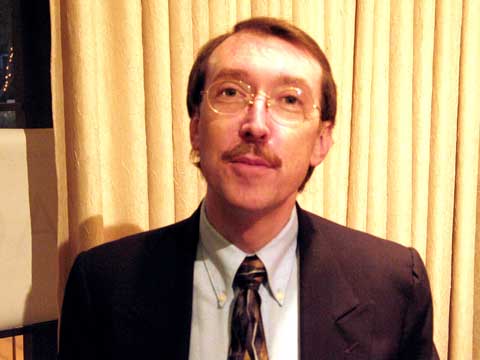
Kevin Hayes of VAC
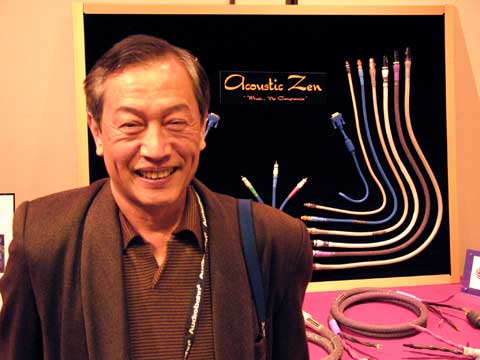
Robert Lee of Acoustic Zen
Afterward, Chris Huston told me that he was from Liverpool, went to school with John Lennon, and was with a band in the early 60’s called The Undertakers, for whom The Beatles once opened. Chris went on to engineer records for The Who, Led Zeppelin, War, and a large number of other famous bands. He has also designed world-class recording studios, such as the Sound Kitchen in Nashville. An ideal candidate for a future interview, I’d say.
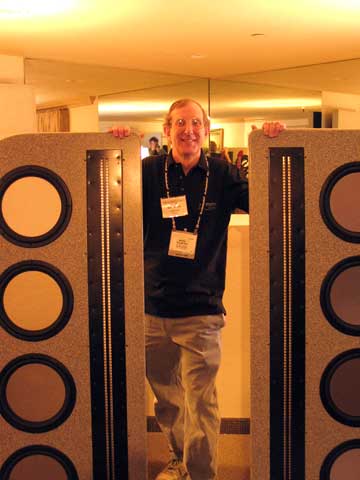
Mark Gilmore
Abraham Laboriel, who is said to be "the most recorded bass player in the world," put on some demonstrations of his prowess that were generating good buzz around the show. He was playing through new hybrid ribbon-and-cone-woofer loudspeakers from Mark Gilmore of Gilmore Audio, powered by Atma-Sphere tubed monoblocks. Watching Abraham play electric bass was a joy; just when you thought he couldn’t get any better, he did.
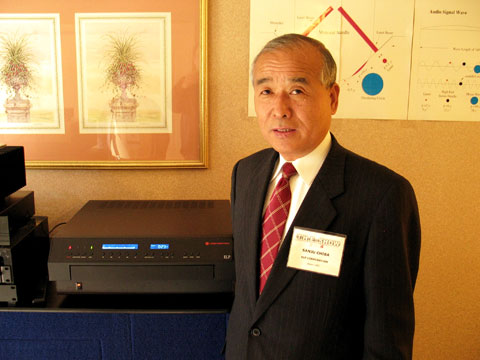
Sanju Chiba of ELP
The Biggest Turntable Paradigm Shift was described to me in detail by Sanju Chiba, president of the ELP Corporation. This gentleman purchased the intellectual property of Finial, the US company that originally attempted to produce a laser turntable. ELP spent five years developing the final product, and five more years marketing it, and report that over 1000 of these wear-free turntables have been sold since 1997. Two lasers read the groove, one for each groove wall. They read higher in the groove than a typical stylus rides, thus sensing a "virgin" portion of the groove. Two more lasers are used to track the groove laterally and aim the read lasers, while a fifth laser keeps track of the height of the record. The spot size of the read lasers is 2 microns, smaller than a typical stylus, and equal to the size of the burnishing facets on the cutting stylus on Stan Ricker’s mastering lathe. The major drawback appears to be that the LP must be squeaky clean; any dust on the record apparently produces major noise. A good record cleaning machine is a must, and ELP recommends the Loricraft. The quality of the associated playback system was poor, so I could make no judgments about sound quality.
The Most Interesting Marriage of Computers and Audio was to be found in the Electra-Print room of Jack Elliano. Vincent Sanders of VRS Audio Systems was exhibiting a computer-based audio system that can copy CDs or LPs (the latter at up to 32 bits/192 kHz sampling). For CDs, the computer acquires the track information from the web, then rips the contents to a hard drive in under 5 minutes. A playlist of up to 1000 tracks can be generated, in any desired genre. The contents of approximately 220 CDs can be stored with no compression of any kind, on a 160 GB hard drive. DVD-Audio discs can also be accommodated, but not SACDs. The system reportedly completely eliminates digital jitter, resulting in sound quality that is better than the original CD. Although I could not vouch for that from the demonstration that was presented, I can say that the playback did not sound digital.
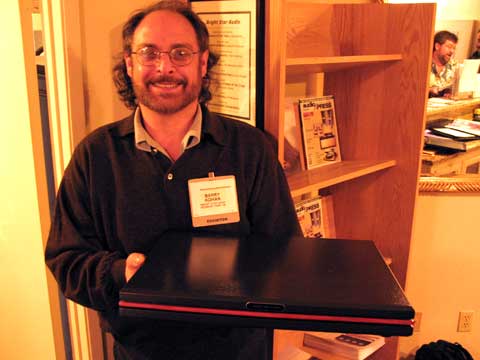
Barry "The Sand Man" Kohan
Barry Kohan of Bright Star Audio showed the Best Grit and Determination for the eighth year running. And running he was, installing his justifiably famous resonance control products in myriad rooms around the show. (This entire line started from a humble box of sand that Barry had sitting under a turntable many years ago, hence the grit.) Some of my favorite products of Barry’s over the years have been the Rack of Gibraltar and the Padded Cell (sporting the catchphrase "Every audiophile needs a padded cell"). Whatever happened to that, anyway? I need one desperately. The latest product featured at the show was the IsoRock 3 Reference platform, in Barry’s three official CES rooms. Barry also does the assembly for the new Gilmore loudspeaker mentioned above.
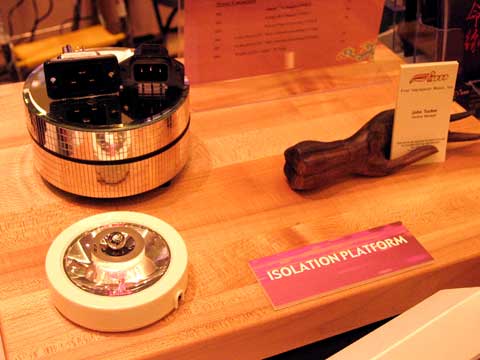
One of Winston Ma’s new maple equipment platforms
Winston Ma of First Impression Music is busily expanding his line, to include very high quality power outlets, IEC connectors and power plugs, interconnect and power cables, maple equipment platforms, and acoustical panels. I am enjoying one of Winston’s duplex AC receptacles in my system now, and plan to install them in the remainder of my system shortly. At the show, Winston introduced the Most Interesting New Acoustical Panels. These are absorbing panels made entirely of natural fibers, designed to be used safely in place of fiberglass, dubbed the Safe Home Acoustic Panel (SHAP).
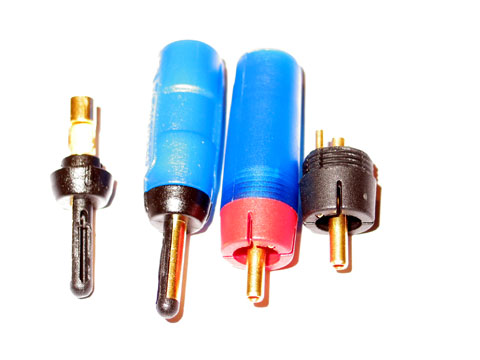
The clever Eichmann plugs
The Most Interesting New Connector was introduced by Eichmann Technologies International from Brisbane, Australia. The Eichmann Bullet Plug is a brand new type of RCA plug. It replaces the standard outer return/ground collar with a tellurium/copper pin. This reportedly solves the problems introduced by a collar with multiple contact points, gaps, and impedance effects. This one is definitely worth investigating.
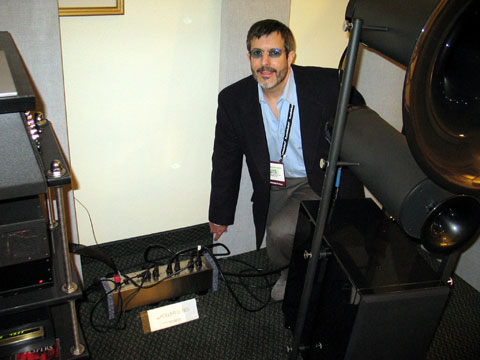
Alan Kafton and the Power Wing, in one of its many rooms in the show
The Most Promising Power Conditioner was the Power Wing, manufactured by World Power and represented by Alan Kafton of audio excellence az. I have one on short-term loan for a tryout in my reference system, and will be able to report back at some point in the future on whether the angels sang and the skies parted. Or maybe even on what it did for my system.
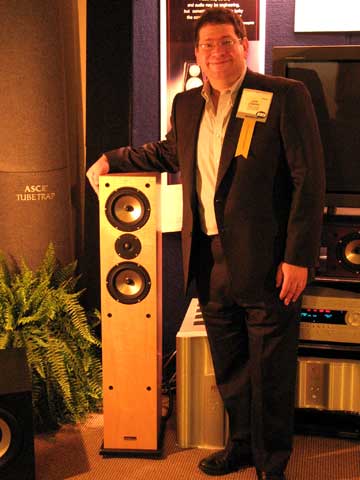
Jeff Joseph
The Most Promising In-Wall Loudspeaker was being shown by Jeff Joseph of Joseph Audio. "The Insider" uses a metal cone woofer and a silk dome tweeter with an infinite slope crossover. The design is said to result in an excellent dispersion pattern that mitigates some of the drawbacks of typical in-wall loudspeakers.
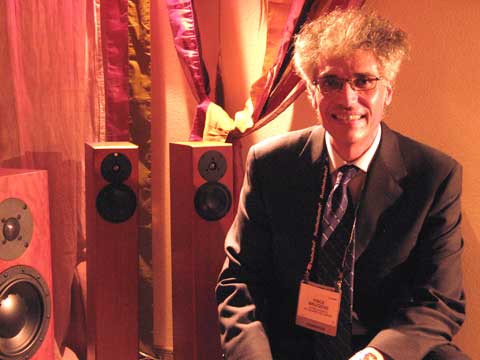
Vince Bruzzese
The Best Kick in the Pants at the show was provided by the Totem Acoustic "Drum" from Vince Bruzzese. This is a cylinder that provides a visceral impact to the underside of a chair or sofa, and it varies as a function of subwoofer output. The Drum is more sophisticated than most such devices, in that its intensity increases as the subwoofer frequency decreases. Just the thing for watching that section of the Kodo Drummers video where all of their instruments fall over. And by the way, I continue to enjoy a pair of Totem Model 1 Signature loudspeakers in my second system. They’ve provided many years of enjoyment.
Finally, Mike Hobson of Classic Records announced that, after searching for the master tapes for three years, they have reissued the album Deja Vu by Crosby, Stills, Nash and Young, with an authentic reproduction of the original jacket. This is exciting news to me, and I look forward to bringing you a review.
Top "Sweet Sixteen" Systems
Now here is a rundown on the sixteen best systems I heard at the show. I’m not ranking them or giving out awards this year. Rather than producing my usual in-depth, analytical, long report on all of these systems, I decided to provide some brief, but hopefully insightful, comments on the systems whose sound I enjoyed the most. Removing the pressure of trying to compare the sound of every system to every other system in a fair and balanced manner let me relax and enjoy the show more this year. The plan worked ... I think ...
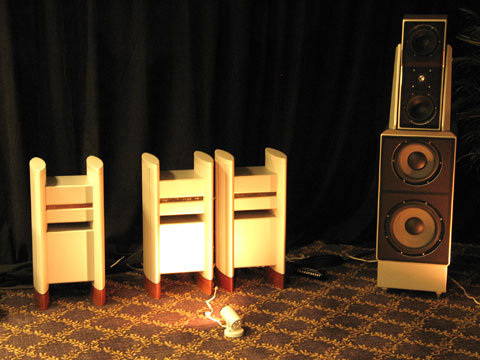
Halcro & Wilson
The Halcro/Wilson room at the San Remo had the same effect on me as last year, as reported above. Two-channel, or incredibly realistic symphony-hall-like surround-sound, could be heard, using Halcro amplifiers, Wilson Audio loudspeakers, and master tapes from Peter McGrath. I would like to thank both Peter and Philip O’Hanlon for staying late on Sunday to give me a demonstration that really knocked my socks off. This system has me completely sold on the benefits of surround-sound done right for listening to music. Bridged Halcro 68s were running Wilson Maxx loudspeakers in the front, while a stereo Halcro 38 was running Wilson Sophias in the rear, with a Wilson Watch Center front and center. What the heck, I have to hand out an award here. This system reproduced the Most Astoundingly Realistic Choral Reproduction that I have ever heard in 25 years of high-end audio. I have years of experience of live choral listening and recording. This system just gets the voices spot-on, with instantaneous transients and an ability to pick out individual voices that is downright spooky. It sounds damn close to what a choir sounds like live. How can I say more? But guys, the fact that you started packing up early meant that I almost missed you this year. Consider staying for press day next year ...
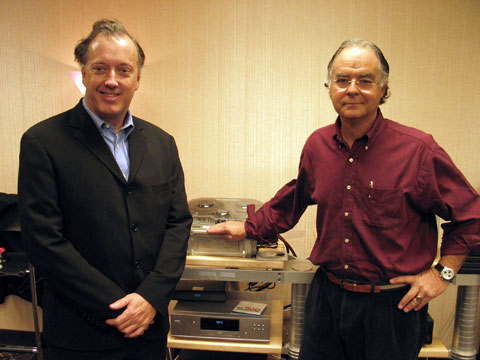
Philip O’Hanlon and Peter McGrath
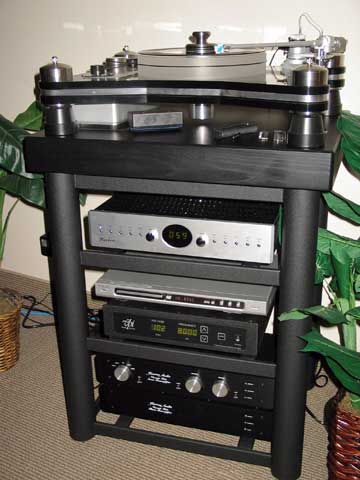
Keith Herron’s equipment rack
Herron Audio is always an oasis of real music amidst a sea of audiophile dreck. Keith Herron has introduced me to more music that I now find indispensable than anyone in the show in recent years. Keith is someone for whom the hardware serves the music, and his low-key approach is much appreciated. Keith’s new HL-1 solid state preamplifier and his prototype M1 power amplifiers were being fed by a VPI TNT HR-X turntable, and were feeding Alon Lotus Elite Signature Series 2 loudspeakers. The sound was transparent, dynamic, smooth, and ultra-musical. It kept Stan Ricker riveted to his chair while I went out, covered more rooms, came back to see if he was ready, went out and covered more rooms, etc. The wonderful new Gene Harris Trio Plus One from Ying Tan’s Groove Note label sounded better here than on any other system we tried. Bravo, Keith.
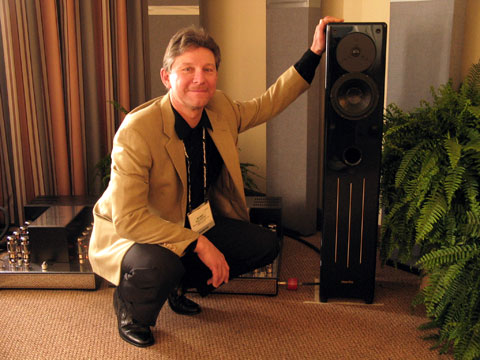
Bobby Palkovic, in the best photo I’ve ever taken of him
It is always a pleasure to spend time in the Merlin Music Systems room. I’ve awarded the gracious Bobby Palkovic best sound in show several times in recent years. Bobby has continued to improve his very highly regarded Merlin VSM loudspeakers, and this year they were sounding exceedingly neutral and transparent, with a really fleshed-out soundstage, basically better than ever. The Merlins were being fed by a VPI TNT 6 turntable, a Convergent Audio Technologies (CAT) SL1 Ultimate preamplifier, and CAT JL3 triode monoblock amps. Thanks for your hospitality, Bobby, and for providing a calm harbor within the boiling tempest of CES for year after year.
